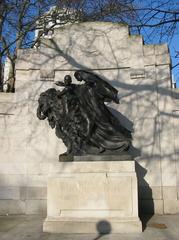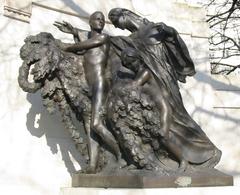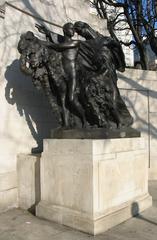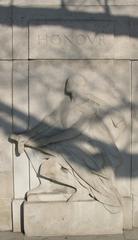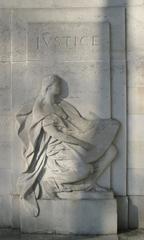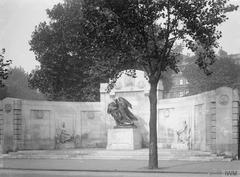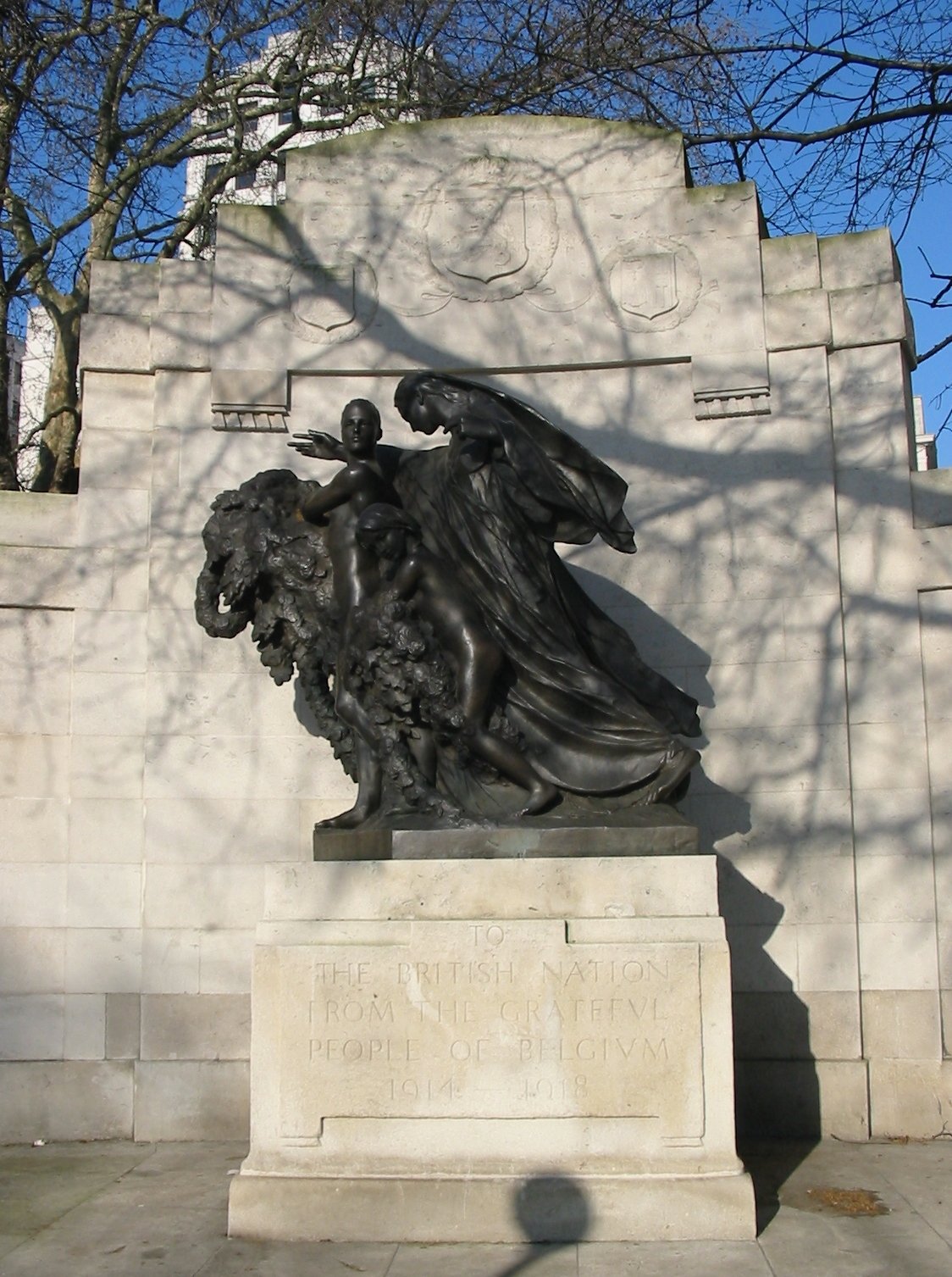
Anglo-Belgian Memorial London: Visiting Hours, Tickets, and Travel Guide
Date: 15/06/2025
Introduction
The Anglo-Belgian Memorial, standing gracefully along London’s Victoria Embankment, is a powerful testament to international solidarity and gratitude, commemorating the United Kingdom’s humanitarian response to Belgian refugees during the First World War. Designed by Sir Reginald Blomfield with a poignant bronze group by Victor Rousseau, the memorial reflects themes of hope, resilience, and enduring alliance. This guide provides in-depth historical background, detailed visiting information, accessibility tips, and suggestions for making the most of your visit.
For official resources, see Historic England, Imperial War Museums, and London Remembers.
Historical Background
Origins and Context
The origins of the Anglo-Belgian Memorial are rooted in the events of 1914, when Germany invaded Belgium, prompting Britain to enter World War I in defense of Belgian neutrality (Stuff About London). The ensuing conflict forced approximately 250,000 Belgians—one of the largest refugee movements in British history—to seek sanctuary in the UK, where they were met with widespread public support (Wikipedia).
Creation and Dedication
Amid the war, Belgian expatriates in London proposed a monument to thank the British nation for its generosity (Kiddle). Funds were raised by public subscription, and the memorial was officially unveiled on October 12, 1920, a date symbolically chosen as the fifth anniversary of nurse Edith Cavell’s execution in Brussels—a moment that resonated deeply in both countries (C20 Society). Princess Clémentine of Belgium presided over the ceremony, with dignitaries from both nations in attendance (Wikipedia).
A reciprocal memorial was later erected in Brussels in 1923, designed by Charles Sargeant Jagger, further underscoring the mutual respect between the two nations.
Design and Symbolism
Architectural and Artistic Collaboration
The memorial’s design features a harmonious blend of architecture and sculpture. Sir Reginald Blomfield, known for his classical war memorials, provided the dignified setting, while Victor Rousseau—a Belgian refugee and acclaimed sculptor—created the expressive bronze group (English Heritage).
Central Bronze Group and Reliefs
The focal sculpture depicts a mourning mother symbolizing Belgium, flanked by a boy and girl bearing garlands—an allegory of gratitude and remembrance. The Portland stone base bears the inscription:
“To the British Nation from the grateful people of Belgium, 1914–1918” (Kiddle).
Relief panels to the left and right represent “Justice” (holding the Treaty of London) and “Honour” (as St George), while additional carvings depict Belgium’s nine historic provinces (bel-memorial.org). The design is further enhanced by medallions of King Albert I and King George V, symbolizing royal alliance.
Heritage and Conservation
The memorial was designated a Grade II listed structure in 1970 and upgraded to Grade II* in 2014, reflecting its artistic and historical importance (dbpedia). Ongoing conservation ensures the preservation of both Portland stone and bronze elements, with periodic restoration to protect against weathering (Kiddle).
Visiting the Anglo-Belgian Memorial
Location and Setting
Located on Victoria Embankment, opposite Cleopatra’s Needle and between Embankment and Westminster Underground stations, the memorial is ideally placed for visitors exploring central London. Its riverside position offers views of major landmarks, with the Victoria Embankment Gardens providing a tranquil backdrop.
Opening Hours and Admission
The Anglo-Belgian Memorial is an outdoor monument in a public space, accessible 24 hours a day, year-round, with no admission fee or ticket required. The surrounding gardens typically open from dawn to dusk; check City of Westminster parks information for seasonal garden hours.
Accessibility
- Wheelchair Access: The gardens are largely wheelchair-friendly with paved paths and step-free access from Embankment and Savoy Street entrances. The memorial itself includes several steps, but the main features can be viewed from accessible paths.
- Amenities: Public toilets (including accessible facilities), benches, and free Wi-Fi are available in the gardens. Nearby cafés and refreshment kiosks operate seasonally.
Guided Tours and Educational Resources
While there are no tours dedicated solely to the memorial, it is featured in many guided walks of Westminster and the Thames Embankment. For self-guided visitors, on-site interpretive panels and QR codes provide historical context. Educational materials for group visits and school groups can be accessed from Imperial War Museums and War Memorials Online.
Special Events
Annual remembrance ceremonies, including Armistice Day and Belgian national commemorations, take place at the memorial, often attended by dignitaries, veterans’ groups, and the public. Event details are published in advance on the City of Westminster events calendar.
Enhancing Your Visit
Best Times and Photography
The site is picturesque year-round. Spring and summer bring lush gardens, while early morning and late afternoon offer optimal lighting and fewer crowds for photography. The Thames and London skyline provide a dramatic backdrop.
Travel Tips
- Transport: Use Embankment or Westminster Underground stations for the shortest walk.
- Weather: Dress for the weather—London’s climate can be changeable.
- Nearby Attractions: Combine your visit with the Palace of Westminster, Westminster Abbey, the Churchill War Rooms, and the National Gallery, all within walking distance.
Frequently Asked Questions (FAQ)
Q: What are the visiting hours for the Anglo-Belgian Memorial?
A: The memorial is accessible 24/7 as an outdoor monument; the gardens are open dawn to dusk.
Q: Is there an admission fee or are tickets required?
A: No, the memorial and gardens are free to visit—no tickets needed.
Q: Is the memorial wheelchair accessible?
A: The gardens are mostly accessible with step-free paths. The monument itself is reached via steps but is visible from accessible areas.
Q: Are guided tours available?
A: The memorial is included in many walking tours of Westminster and the Embankment; check with local operators.
Q: Are there commemorative events?
A: Yes, public remembrance ceremonies and wreath-laying take place annually.
Q: Can I take photographs?
A: Yes, photography is permitted and encouraged.
Conclusion
The Anglo-Belgian Memorial stands as a moving symbol of gratitude, resilience, and friendship between Belgium and the United Kingdom. Its location, artistic merit, and historical resonance make it a must-visit for anyone interested in London’s heritage. Whether visiting independently or as part of a guided tour, the memorial offers a profound window into the humanitarian spirit of World War I and the lasting bonds it forged.
For more travel tips, downloadable audio guides, and up-to-date information on London’s historical sites, download the Audiala app and follow us on social media.
